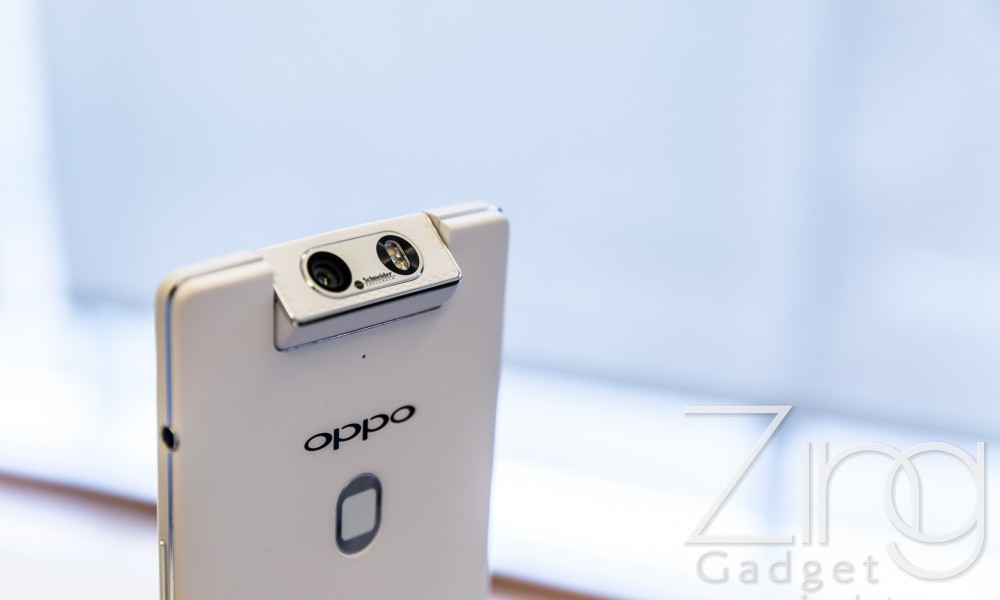The Oppo N3 is the latest generation of N series smartphone from Oppo. It’s brother, the Oppo N1 was first smartphone to feature the rotating rear camera that can switch to the front for taking good selfies. The Oppo N3 a newer model of the N series that comes with auto-rotating rear camera which can be controlled in the camera interface. In terms of size and weight, the N3 has a has smaller display size and lighter weight compared to N1. Lets look at our review of the Oppo N3!
Specifications:
- 5.5 inches 1080p Full HD display
- Qualcomm Snapdragon 801 Quadcore processor (Highest clock rate at 2.3 Ghz)
- 2GB RAM
- 32GB ROM (microSD expansion up to 128GB)
- 16MP rear rotating camera
- 3000mAh battery
- Dual SIM Standby (SIM 2 slot can be used as microSD slot)
- Dimension – 161.2 x 77 x 9.9 mm
- Weight: 192g
- Android 4.4.4 (Colour OS 2.0)
1. Appearance

The Oppo N3 uses the convetional candy bar shape design that appears straight and solid. The whole body was surrounded with aluminium alloy frame while the bottom of the smartphone appears slightly curved. Aparts from the metallic edges, other part of the body appear white and clean just like a empty paper.
When we first received the review model, we were amazed by the thin bezel and large display. However we were slightly disappointed when the screen was turned off because turns out the bezel was slightly larger than expected. Due to the use of auto-rotate camera, the bezel on the top was incredibly large. Beneath the display there are 3 conventional Android control buttons that are recent menu, home and back key.


The main selling point of this smartphone is the rotary camera that was positioned in the top of the phone. The camera and flashlight was placed on a small rectangle block covered in leather-like texture that can be rotated when taking pictures. The edge of the camera and flashlight module was also surrounded by the aluminium alloy frame that appears well fitted with the body design.
The flashlight and the camera was both placed within a black circle that appears symmetrical from the center.

The metallic frame on the bottom is used as a part of notification light display. When a notification appears in the smartphone, the notification light will be reflected by the metallic bar and shown on the bottom of the device. Speaker grills were also found on the bottom part of the Oppo N3. However, the common problem bottom speaker are the sound could be covered by hand if the phone is held horizontally.

The polycarbonate back cover appears as white as snow and comes with a fingerprint sensor that distinct itself from the Oppo N1. The fingerprint sensor was surrounded by a reflective oval material thus users can determine the location of fingerprint sensor accurately without looking at the back. The Oppo logo was embeded on the top of the finger print sensor and followed by the camera and flashlight module that appeared as two O on the top.


One of the unique design in Oppo N3 was the bulky metallic frame that protrude in the bottom part of the body. The protruding metallic frame is likely to act as protection against screen cracks when the device was accidentally dropped onto the floor. The power button, SIM and microSD slot and charging slot was found on the left side of the device. The volume rocker and the earphone jack was located on the right and the corner part of the device respectively.

The SIM slot was specially design on top of the power button. It was designed to fit into the body and can only be open up by pressing the small hole with a tiny needle. Although it is not convenient, it prevents easy accessibility of SIM cards. The SIM card module was pretty unique, as it allow 2 SIM card to be placed together or 1 SIM and 1 microSD. With that being said, the insertion of microSD will have to remove one additional SIM card in order to operate in the device.
2. Display

The Oppo N3 uses 5.5 inches Full HD display with pixel density at 403 ppi. Although 108op display in smartphone today was not the highest definition possible, however Full HD display still has it own advantages. Previously we have compared the display of this device with Lenovo Vibe Z2 Pro. And now we will have a recap of the comparison from both device.

The Oppo N3 has a slightly dimmer screen compared to Lenovo Vibe Z2 Pro. Note that the Oppo N3 on the right has better colour reproduction compared to the left.






The Oppo N3 on the right shows a better colour reproduction in blue and black whereas the Lenovo Vibe Z2 Pro on the left has better display on red, yellow and white. Thus both devices has their own merit in terms of display.

Another merit from the display is that there white balance of the display was well adjusted. Although it was just another common 1080p display, the display from the Oppo N3 does has satisfactory display performance.
3. Software and OS

The Color OS user interface appears simplistic and easy to operate as most application can be found when swipped from left to right. The icons and theme were well groomed and appears stylish just like the smartphone.

If the default theme does not suit your taste, you can download more theme from the oppo market pre-installed in the device. There is large variety of choice for theme selection up to individual preference.

The status bar and quick settings bar was simplistic and clean. The default interface after swiping down the status bar is shown on the left. More settings can then be display shown on the right.

The Oppo settings interface comes majority in white followed by green. This style highly suits the logo design of the Oppo.

The Oppo N3 comes with gesture control that is determined by the proximity sensor. Users can double tap to turn on and off the screen as well as draw ‘O’ to instant launch the camera application. Swiping 3 fingers down will take a screenshot of the display.

The display of the Oppo N3 is also resizable. This provides a lot of convenience during single handed operation although the icon now appears more packed.
In short, settings in the Oppo N3 are easy to manipulate and application are easy to operate. The Oppo N3 also comes with 15 pre-installed application which includes the common Google App such as Google+, Hangouts, Gmail and others. The pre-installed application has taken up around 900 MB of internal storage and thus further optimization of space by removing unnecessary application can be done.
4. Camera

The camera is one of the top selling point of the Oppo N3. The rotational camera was inherited from the Oppo N1 and now comes with electrical rotor for auto camera rotation. All of the rotation settings can by controlled on the phone camera software and users does not have to manually turn the camera module while worrying lens contamination.
Oppo uses 16MP rear camera certified by well-known German manufacturer – Schneider Kreuznach. It can capture image up to 3456 x 4608 pixel which belongs to superior image quality. This could be another device dedicated for selfie addicts as well as photography enthusiasts.


The camera application in Oppo N3 comes with Oppo market where users can install more shooting mode for different scenarios. Those available modes includes Beauty shot, GIF, Panaroma and others. 
Here is an example of GIF created from the Oppo N3

Here comes the favourite part for the camera enthusiast. Users now have the freedom to manually adjust the white balance, exposure and ISO of the camera to capture different images. in the expert mode.

Here comes the selfie from our pretty staff! This image is captured with beutify mode, does it looks amazing?

However, you were required to long press the arrow button highlighted above to be able to select more camera shooting mode and option.
Let’s see some sample pictures of default shooting mode

The macro shot from the Oppo N3 does highlight the details of the texture on skin and the oil. Do you feel hungry right now? 🙂

The camera also takes amazing picture in brighter environment. Note the details of the flower were accurately represented in the picture.

Here is another macro shot from Oppo N3. Although main object was highlighted and background was blurred, the flower pedals does appeaer slight blurry in the pictures.

In outdoor shooting environment, the colours and details of the leaves were shown but there was slight purple tint issue on the background.

This picture was taken in a cloudy day. Notice that the background does not appears dark and dull. This indicate the camera of the Oppo N3 has good white balance adjustment.

Although this image was taken in a cloudy day, there isn’t much noise observed in the final image capture from the camera.

In extreme low light environment, the Oppo N3 manage to capture minor details of the plant. However the picture suffers from lot of noise that affect the overall image quality.

During night street shooting with high luminescence, the picture appears more brighter while but still suffers from noise issue. This could mean that there is room for improvement in future Oppo device in low-light shooting environment.
Here comes the comparison with the Vibe Z2 Pro


Pictures taken from Oppo N3 are shown in the top. In contrast with Vibe Z2 Pro, the picture appears brighter but it sacrifices alot of detail from the building. The Vibe Z2 pro has darker images and comes with alot of noise.


The Oppo N3 (Top) shows a warmer picture when comes to outdoor shooting. Building and the sky also appear brighter than the Oppo N3. However, both smartphone camera is able to retain most detail from the building.
The rotating camera was the major feature of the Oppo N3. It comes with high variety of camera shooting modes and the image taken from the 16MP camera appears amazing. Overall the pictures taken from the Oppo N3 appears more warmth compared to Lenovo Vibe Z2 Pro in bright environment whereas the night shooting could be dreadful. With the auto-rotating camera, it is believed that this camera will be widely used in taking panaroma pictures as well as taking impressive selfies in the younger generation.
5. Durability/ Battery Life
The Oppo N3 uses 3000mAh battery which is likely to be sufficient to use as daily driver. However, the battery life also depends on the smartphone performance and the efficiency of the components. Without further ado, let’s look at the endurance test results.
| Activity | Time (hour) | Battery usage (%) |
| Navigation services with data | ½ hr | 13 |
| Facebook with data | ½ hr | 8 |
| Facebook with WiFi | ½ hr | 7 |
| Web browsing with WiFi | ½ hr | 8 |
| Gaming with WiFi | ½ hr | 12 |
| Youtube | ½ hr | 6 |
| Social IM+camera+WiFi | ½ hr | 8 |
| Music playback | ½ hr | 4 |
| Video playback @ 1080p | 1 hr | 18 |
There is only 16 percent battery left after the 5 hours endurance and stress test. However, only 3% of battery is drained during 8 hours of standby time which is relatively little compared to other devices. With VOOC quick charge technology, the battery capacity shouldn’t be an issue for users.
Since Oppo officially stated that 75% battery can be replenished with 30 minutes charge, we put this claim into test. After the battery was just left at 4%, we charged it for 30 minutes and found that the battery level is now at 78%. In conclusion, VOOC quick charge technology is certainly impressive.
6. Performance
Let’s see the benchmark result from Oppo N3



In terms of benchmark scores, the Oppo N3 belongs to high performance devices since it is packed with powerful processor and specification. During the system stability test there was some error occurred in the device and thus it shows unstable result.

After a series of benchmark test, we put the Oppo N3 is test. The Asphalt 8 runs smoothly in this device with no lag or delay experienced. However, the application was suddenly crashed with force close notification displayed on the screen. We also found that other apps such as internet browser and google play store will crash randomly during our testing period. This indicates Oppo N3 has an unstable system.
The photo processing also becomes slower when we began to take more photo although there is alot of space available in the device. Such issue could be worrying as system stability is a top priority for maintaining a good user experience.
7. O-Click

The Oppo N3 also comes with a tiny accessories named as O-click. The O-clock contains a solid button surrounded by metallic circle and serves many function for the device.


O-click can be connected by Bluetooth technology on the Oppo N3. Once connected, Oppo N3 can serves as toggle for launching music player and camera shutter. Double pressing on the button on the O-click also activates the alarm in the smartphone which allows you to locate your phone. When the Oppo N3 receives a notification, the LED in the O-Click will starts blinking to notify the user. All of the features are optional and can be manually adjusted.
Conclusion

The Oppo N3 features a design that appears simplistic but not too plain. The protruding metallic frame with notification LED and auto-rotating camera is the best selling point of this device. There is alot of innovative new design on the Oppo N3 that depends on user style preference.
The auto-rotate camera is one of the best feature of the the Oppo N3. It is able to capture clear and beautiful pictures during outdoor shooting and macro shot. However there is lot of improvement can be done on low light shooting.
One of the biggest concern of the Oppo N3 is the system stability. The random force close and app crashing on the Oppo N3 could be a disappointment for user as it affect the overall user experience. Hopefully there will be an update for Oppo N3 to solve these critical issues. Lastly, Oppo N3 still have big room for improvements to be able to compete with other flagship devices.
Author: Jiayi.goh




